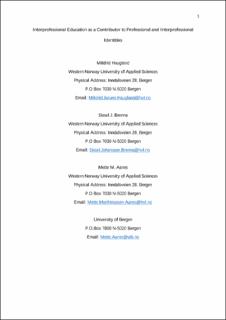| dc.contributor.author | Haugland, Mildrid Jorunn | |
| dc.contributor.author | Brenna, Sissel Johansson | |
| dc.contributor.author | Aanes, Mette | |
| dc.date.accessioned | 2020-02-21T11:31:23Z | |
| dc.date.available | 2020-02-21T11:31:23Z | |
| dc.date.created | 2020-01-29T16:43:38Z | |
| dc.date.issued | 2019 | |
| dc.identifier.citation | Haugland, M., Brenna, S. J., & Aanes, M. M. (2019). Interprofessional education as a contributor to professional and interprofessional identities. Journal of Interprofessional Care, 1-7. | en_US |
| dc.identifier.issn | 1356-1820 | |
| dc.identifier.uri | https://hdl.handle.net/11250/2643214 | |
| dc.description | This is an Accepted Manuscript of an article published by Taylor & Francis in Journal of Interprofessional Care on 9 Dec 2019, available online: https://www.tandfonline.com/doi/full/10.1080/13561820.2019.1693354 | en_US |
| dc.description.abstract | According to the World Health Organization interprofessional education (IPE) is a necessary step in preparing a collaborative practice-ready health work force. However, the processes of developing professional identity within interprofessional education programs have not been fully explored and require a deeper understanding. Participation in interprofessional education groups may influence the development of professional identity including increased awareness of one’s own profession-specific competence as well as socialization into a professional role. Interprofessional education is a dynamic social process related to students’ memberships in IPE-groups. We conducted focus groups with representatives from students in seven different professional education programs involved in interprofessional education during all three years of their educational programs. We used the principles of systematic text condensation as an analytical frame. This article is a contribution toward grasping how IPE can contribute to both professional and interprofessional identity. Group collaboration in interprofessional education enabled students to identify with their profession as well as creating a safe place to gain insight into other professions’ competencies. Moreover, students could obtain knowledge about being a professional participant and could enrich their professional identity, as they were involved with students from other professions. IPE-groups strengthened professional identity rather than threatened it. | en_US |
| dc.language.iso | eng | en_US |
| dc.publisher | Taylor & Francis | en_US |
| dc.subject | focus groups | en_US |
| dc.subject | interprofessional education | en_US |
| dc.subject | professional identity | en_US |
| dc.subject | collaboration | en_US |
| dc.subject | qualitative method | en_US |
| dc.subject | education | en_US |
| dc.title | Interprofessional education as a contributor to professional and interprofessional identities | en_US |
| dc.type | Peer reviewed | en_US |
| dc.type | Journal article | en_US |
| dc.description.version | acceptedVersion | en_US |
| dc.subject.nsi | VDP::Medisinske Fag: 700::Helsefag: 800 | en_US |
| dc.source.pagenumber | 1-8 | en_US |
| dc.source.journal | Journal of Interprofessional Care | en_US |
| dc.identifier.doi | 10.1080/13561820.2019.1693354 | |
| dc.identifier.cristin | 1785539 | |
| cristin.unitcode | 203,11,2,0 | |
| cristin.unitname | Institutt for helse og funksjon | |
| cristin.ispublished | true | |
| cristin.fulltext | postprint | |
| cristin.qualitycode | 1 | |
